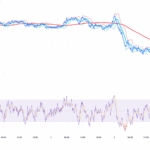PolygonLatest Mentions
Track Polygon news, price action, and on-chain developments with Crypto Hunter's comprehensive coverage. Our curated feed brings together breaking headlines, technical analysis, protocol updates, and regulatory developments from trusted sources—so you can make informed decisions faster.
 Now That The Chainlink Price is Dead, What’s Next For It?
Now That The Chainlink Price is Dead, What’s Next For It?What’s going on with the Chainlink price? I’ve run this through several highly advanced models. Each one says the same thing: the bull market isn’t over yet- it’s just beginning. There was no euphoria No blow off top No alt season Not a single indicator With all that said, it seems that interest in crypto has topped out. Besides a select few altcoins like Zcash, Dash and Internet Computer, the entire crypto market is down more than 4%. Maybe notable Wall St. investors like Michael Burry were right that crypto and AI are in a bubble. Sometimes, we see bubbles.Sometimes, there is something to do about it.Sometimes, the only winning move is not to play. pic.twitter.com/xNBSvjGgvs — Cassandra Unchained (@michaeljburry) October 31, 2025 One altcoin that is down 35% over the last month is Chainlink. Not every alt gets a euphoria phase in any given cycle; sometimes it’s just over anon. ChainLink’s All Time High (ATH) of $ 52.82 was reached on 10 May 2021, and is currently -70.8% down, making some call its holders the cuckolds of crypto. Is it, and will Chainlink rebound? DISCOVER: 20+ Next Crypto to Explode in 2025 Is The Chainlink Price Dead? Market Cap 24h 7d 30d 1y All Time Chainlink may appear “dead” on the charts, but beneath the surface, its technology continues to anchor some of the most significant blockchain integrations in the world, most recently with the central banks of Hong Kong and Brazil. A recent Reddit poll revealed what many in crypto already suspect: most investors don’t actually care about the tech. Out of 919 respondents, 50% said they only care about price, 38.5% care about both, and just 11.5% are interested purely in the technology. That might explain why Chainlink’s market price remains muted even as it powers real-world projects with central banks and financial institutions. Also, even with partnerships, its value is still purely speculation, like many things in this market. We’re excited to announce that Chainlink is powering cross-border DvP settlement between the Central Bank of Brazil (@BancoCentralBR) & Hong Kong Monetary Authority (@hkmagovhk) alongside Banco Inter, Standard Chartered, GSBN, & 7COMm in the Drex program.https://t.co/pdodcDMkuC… pic.twitter.com/6cIIOjif1K — Chainlink (@chainlink) November 3, 2025 In a cross-border test of CBDC interoperability, Banco Inter, Chainlink, and the central banks of Brazil and Hong Kong completed a pilot connecting Brazil’s Drex network with Hong Kong’s Ensemble system. Using LINK, the pilot automated tokenized payments and asset transfers, a model that Banco Inter says could cut trade costs and expand access for small firms. “By supporting tokenized payments and automating title transfers via smart contracts, the platform lowers costs, reduces risk, and opens international markets to small and medium-sized businesses,” Banco Inter said. Does the Market Still Undervalue Chainlink? Although the price for Chainlink has been a wet fart, according to DefiLlama, it now secures over $55 Bn across Ethereum, Polygon, and Avalanche, a web of smart contracts quietly pulsing beneath the surface of a tired market. Wallet activity is climbing, up 14% month-over-month, even as LINK trades flat near $12. (Source: TradingView) While the crowd chases flashier bets, Chainlink is integrating itself into the global financial system. From central banks testing tokenized trade finance to Drex’s pilot in Brazil, its oracles are everywhere, unseen but essential. In a market obsessed with speculation, Chainlink is doing something unfashionable — it’s building infrastructure that governments are starting to rely on. The Bottom Line For The Chainlink Price Investors may call Chainlink “dead,” but that says more about market psychology than about the project itself. Or who knows? All of this should also be a lesson that if your project can’t generate marketing or hype, then it may be a good project, but won’t move up in price. Maybe you’re okay with that. Maybe not? Ask yourself these kinds of questions. While most traders chase volatile price action, Chainlink is quietly building the rails for the next era of tokenized finance. However, it will be over the next five years that we will see how much that is worth. EXPLORE: XRP Price Jumps 11% After SEC Crypto Unit Tease XRP ETF Progress Key Takeaways What’s going on with the Chainlink price? I’ve run this through several highly advanced models. Each one says the same thing that bulls will get revenge. While most traders chase volatile price action, Chainlink is quietly building the rails for DeFi The post Now That The Chainlink Price is Dead, What’s Next For It? appeared first on 99Bitcoins.
 Crypto Community Divided on DeFi Trust Implications After $128M Balancer Exploit
Crypto Community Divided on DeFi Trust Implications After $128M Balancer ExploitVeteran decentralized exchange (DEX) Balancer v2 suffered a major hack on Monday, losing over $128 million and raising questions about whether users can trust even long-established, audited decentralized finance (DeFi) platforms.On-chain data showed roughly $128 million in digital assets sent to the hacker’s wallet across multiple blockchains, including 6,587 WETH (~$24.5 million), 6,851 osETH (~$26.9 million), and 4,260 wstETH (~$19.3 million), according to PeckShield. This marks Balancer’s largest hack to date.The losses affected several networks, including Ethereum, Polygon, Base, Arbitrum, Optimism, Sonic, and Berachain. Balancer’s native token, BAL, fell 11.1% to $0.87, according to CoinGecko. Meanwhile, the protocol’s total value locked (TVL) fell from $776 million to $406 million over the past 24 hours, according to DeFiLlama.To continue reading this as well as other DeFi and Web3 news, visit us at thedefiant.io
 Balancer Hack: $70M Lost in Record Ethereum DeFi Breach
Balancer Hack: $70M Lost in Record Ethereum DeFi BreachOne of Ethereum’s leading DeFi protocols, Balancer, which also functions as an established automated market maker (AMM) on the network, suffered a significant exploit today (November 3), resulting in losses exceeding $70M. On-chain data shows that multiple Balancer liquidity pools were drained in rapid succession, with the stolen tokens quickly transferred to a newly created wallet controlled by the attacker. We’re aware of a potential exploit impacting Balancer v2 pools. Our engineering and security teams are investigating with high priority. We’ll share verified updates and next steps as soon as we have more information. — Balancer (@Balancer) November 3, 2025 What we Know About the Balancer Hack So Far The attack targeted Balancer’s V2 vaults and liquidity pools, exploiting a vulnerability in smart contract interactions. Preliminary analysis from on-chain investigators points to a maliciously deployed contract that manipulated Vault calls during pool initialization. Improper authorization and callback handling allowed the attacker to bypass safeguards. This enabled unauthorized swaps or balance manipulations across interconnected pools, resulting in the rapid depletion of assets. The exploiter initiated a series of transactions starting with a key Ethereum mainnet transaction (0xd155207261712c35fa3d472ed1e51bfcd816e616dd4f517fa5959836f5b48569), which funneled assets to a new wallet under their control. Funds were then consolidated, likely for laundering via mixers or bridges. Balancer’s composable design, where pools interact heavily, amplified the flaw. Similar issues have plagued AMMs before, often tied to how they handle deflationary tokens or pool rebalancing. Full forensic details are still emerging, with auditors like PeckShield and Nansen involved. There is no evidence of a private key compromise; this was a pure smart contract exploit. The swift execution of the transfers suggests the attacker had a deep understanding of Balancer’s smart contracts, potentially exploiting a flaw in how the platform handles swaps or manages pool balances. DISCOVER: The 12+ Hottest Crypto Presales to Buy Right Now Balancer Reacts, Community on Edge At the time of writing, Balancer has posted just one update, confirming the hack and assuring the community an investigation is underway. The DeFi protocols post on X reads: “We’re aware of a potential exploit impacting Balancer v2 pools. Our engineering and security teams are investigating with high priority. We’ll share verified updates and next steps as soon as we have more information.” The lack of communication has fueled uncertainty within the DeFi community, as users scramble to understand the scope and cause of the breach. Blockchain analysts have advised traders to refrain from interacting with Balancer pools until further information is released, warning that additional vulnerabilities may still be present. Market Cap 24h 7d 30d 1y All Time Meanwhile, Balancer’s native token, BAL, has declined by over 15% in the past 24 hours, due to both shaky market conditions and investor unease with the latest eight-figure exploit. Worryingly, this is not Balancer’s first encounter with hackers. In fact, the platform has now suffered three major security incidents in five years, an unsettling record for one of DeFi’s longest-running protocols. In 2020, attackers exploited Balancer’s handling of deflationary tokens, draining roughly $500,000. Then, in 2023, another vulnerability in its “boosted pools” led to $900,000 in losses despite prior security warnings. The latest $70M attack dwarfs those previous incidents, making it Balancer’s most severe exploit to date and one of the largest DeFi hacks of 2025. DISCOVER: 15+ Upcoming Coinbase Listings to Watch in 2025 Update to the Balancer Hack: More Funds Drained Across Multiple Networks Update: @Balancer and its forks are under attack, with total losses across multiple chains reaching ~$128.64M so far. https://t.co/67XGX5RcRR pic.twitter.com/FIwx20ALSz — PeckShieldAlert (@PeckShieldAlert) November 3, 2025 Multiple blockchain analysts have released an update on the Balancer breach within the last hour. As of now, over $128 million has been drained by the hacker across multiple chains to which the Balancer protocol is forked. Over $99M has now been stolen from Ethereum, while $12.8M has been drained from Berachain, $6.8M from Arbitrum, $3.9M from Base, $3.4M from Sonic, $1.58M from Optimism, and $232K from Polygon. The hack on the smaller chains represents a significant percentage of the network’s TVL (Total Value Locked). For example, per DefiLlama data, Sonic has just $150M in TVL and has been drained for $3.4M, approximately 2% of the total value locked on the network. It is concerning from an optics point of view that the attack appears to be still ongoing, with more funds being lost even now, and no update from the Balancer team since 10:00 UTC. EXPLORE: Best Meme Coin ICOs to Invest in 2025 Join The 99Bitcoins News Discord Here For The Latest Market Updates The post Balancer Hack: $70M Lost in Record Ethereum DeFi Breach appeared first on 99Bitcoins.
 Balancer Hacked AGAIN, Over $128M Stolen: Will Ethereum Layer-2s Shut Down?
Balancer Hacked AGAIN, Over $128M Stolen: Will Ethereum Layer-2s Shut Down?Unfortunately, crypto hacks happen all the time. Every time funds are stolen from a top-tier dApp, it becomes a huge morale dent for users and developers. The Bybit hack garnered negative press but subsided quickly when the exchange assured the community that it would continue processing transactions regardless of the $1.3 billion loss. Today, however, is yet another sad day for Balancer and DeFi. Earlier today, Balancer, one of the OG DeFi protocols, was hit (again), and the results are bad, not for the dapp but for the entire DeFi scene and Ethereum layer-2s. Before today, Balancer managed over $775 million, but the protocol is quickly bleeding. We’re aware of a potential exploit impacting Balancer v2 pools. Our engineering and security teams are investigating with high priority. We’ll share verified updates and next steps as soon as we have more information. — Balancer (@Balancer) November 3, 2025 DISCOVER: Best New Cryptocurrencies to Invest in 2025 Balancer Hack: Over $120M And Rising Lost To understand what’s going on, we must first know what Balancer does. For beginners, Balancer is a decentralized automated market maker (AMM) protocol on Ethereum. From the dapp, developers on other Ethereum-compatible chains can also build programmable liquidity solutions. That you can fork Balancer V2’s code is a bonus. If you don’t have liquidity, you can supply assets and allow users to trade them while earning a yield from any custom liquidity pool straight from Balancer. But here’s the problem: Balancer only relied on a single core contract to manage all vaults. The design was intended to boost gas efficiency, but this became the single largest flaw, now affecting not only Balancer but also all other deployments that relied on its code. Here's everything you need to know about the Balancer Hack: 1. The attack targeted Balancer's V2 vaults and liquidity pools, exploiting a vulnerability in smart contract interactions. Preliminary analysis from on-chain investigators points to a maliciously deployed contract that… pic.twitter.com/udAM4hB0OD — Adi (@AdiFlips) November 3, 2025 The hacker targeted the “manageUserBalance” function, effectively taking over vault withdrawals while bypassing sender validation. So far, over $128 million have been drained from vaults across multiple chains, including Berachain. Update: @Balancer and its forks are under attack, with total losses across multiple chains reaching ~$128.64M so far. https://t.co/67XGX5RcRR pic.twitter.com/FIwx20ALSz — PeckShieldAlert (@PeckShieldAlert) November 3, 2025 The loss will likely grow because after the hacker drained Balancer pools on Ethereum, the layer-1, the next targets were bridged equivalents on layer-2s, that is, wrapped tokens. What this is creating is a “domino effect” where a protocol using Balancer v2 code, especially if it’s a layer-2, has to pause operations until the flaw has been fixed. Balancer v2 (+forks) exploited for over $100M+TLDR: Balancer v2 and it's forks are affected:• ETH → balancer → 70m• Arbitrum → balancer → 6m• Base → balancer → 4m• @SonicLabs → beets → 3.4m• OP → beets → 283k• Polygon → balancer → 117k Exploiter is… pic.twitter.com/yTTtrS5L3S — Blub (@DeFi_Blub) November 3, 2025 DISCOVER: 9+ Best Memecoin to Buy in 2025 Berachain Halts Chain Out of caution, Berachain, which is supposed to mirror the Ethereum mainnet and run 24/7, has been paused. In a post on X, the team said its validators have “coordinated” purposefully to halt the platform as they scramble to perform an emergency hard fork in order to address the Balancer hack. The Berachain validators have coordinated to purposefully halt the Berachain network as the core team performs an emergency hard fork to address Balancer V2 related exploits on the BEX. This halt has been executed purposefully, and the network will be operational shortly upon… — Berachain Foundation (@berachain) November 3, 2025 They are also aware that some may not be happy, but their primary objective is to protect over $12M of user funds. Beefy, a yield optimizer, has also paused all products linked to Balancer. Balancer V2 Exploit: All Beefy Balancer V2 products are paused. Our team is monitoring the situation closely. We will cooperate to ensure all losses are properly captured, and that Beefy users participate fully in any recovery. Our full support to the @Balancer team. pic.twitter.com/eC2JCkldRz — Beefy (@beefyfinance) November 3, 2025 They also promise to cooperate and ensure that all losses are properly accounted for. The question now is: Will other protocols, most of them being DEXes, follow suit? On Beets DEX, there are over $6.6M in total value locked (TVL), for instance, and this is just one of the over 20 platforms that have forked Balancer V2’s code. (Source: DeFiLlama) DISCOVER: 10+ Next Crypto to 100X In 2025 Balancer Hack Over $128M Lost, Berachain Halts Balancer is an DeFi OG Protocol managed over $700M before hack Over $128M withdrawn after smart contract exploit Berachain validators take caution, pause chain The post Balancer Hacked AGAIN, Over $128M Stolen: Will Ethereum Layer-2s Shut Down? appeared first on 99Bitcoins.
 BlackRock's BUIDL Fund Sees Share on Ethereum Drop 60%
BlackRock's BUIDL Fund Sees Share on Ethereum Drop 60%BlackRock's tokenized fund BUIDL saw its market capitalization on the Ethereum network drop by roughly 60%, while allocations on several other supported blockchains grew more than tenfold. Data from RWAxyz shows that the $2.8 billion fund’s holdings on Avalanche, Aptos, and Polygon jumped to around $554.7 million, $544.1 million, and $530.9 million as of Oct. 30, up from just $54.3 million, $43.4 million, and $30.7 million respectively as of Oct. 19. Over the same time period, the $2.4 billion of the fund on the Ethereum network dropped to about $990 million.BUIDL was originally launched only on Ethereum in March 2024, before beginning its expansion to other blockchains just under a year ago, with the vast majority of the fund remaining on Ethereum until this month. To continue reading this as well as other DeFi and Web3 news, visit us at thedefiant.io
 DeFi Earning Aggregator Turtle Raises $5.5 Million
DeFi Earning Aggregator Turtle Raises $5.5 MillionOn-chain liquidity distribution protocol Turtle has raised $5.5 million in new capital, bringing its total funding to $11.7 million. The project will use the fresh funding to expand its engineering team, develop its DeFi yield-earning product infrastructure, and deepen its integrations across multiple blockchain ecosystems, according to a press release shared with The Defiant.The funding round saw participation from institutional investors including GSR, FalconX, Anchorage VC, as well as founders from Polygon, 1inch, and Gnosis.Turtle describes itself as an infrastructure hub that moves liquidity across decentralized finance, connecting capital providers and protocols through a "coordination layer” that matches liquidity with earning opportunities, while tracking wallet and vault activity on-chain.To continue reading this as well as other DeFi and Web3 news, visit us at thedefiant.io
